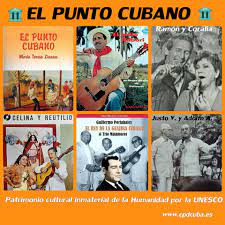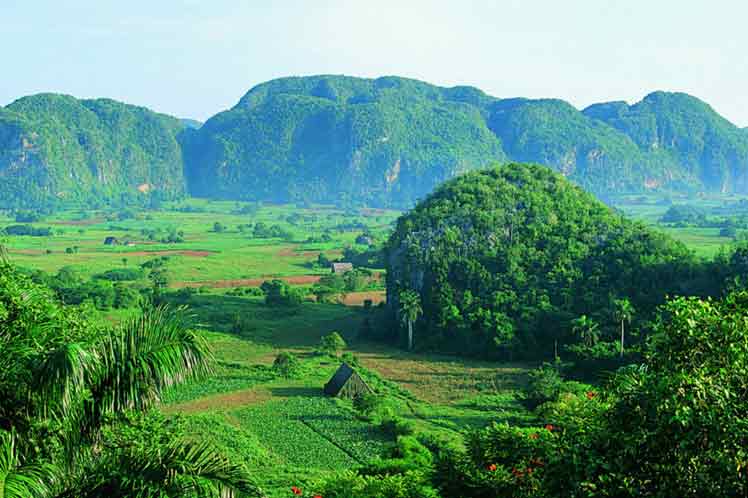La primera música popular interpretada en Cuba después de la conquista fue traída por los mismos conquistadores españoles, y lo más probable es que fuera tomada de la música popular española en boga durante los años de 1500s. Desde estos años hasta los 1800s, algunas piezas bailables que surgieron en España fueron asociadas a la América Hispana, o fueron consideradas como originarias de la América Hispana.
En la musicología cubana hay una lista de importantes personalidades e interpretes que han contribuido a los géneros musicales en Cuba incluye a: Fernando Ortiz, Eduardo Sánchez de Fuentes, Emilio Grenet, Alejo Carpentier, Argeliers León, María Teresa Linares, Celina González, Pablo Hernández Balaguer, Alberto Muguercia y Zoila Lapique. Una segunda generación de musicólogos después de la Revolución de 1959 incluye a: Albita Rodríguez, Zoila Gómez, Victoria Elí, Alberto Alén Pérez, Rolando Antonio Pérez Fernández y Leonardo Acosta.
MUSICA CAMPESINA
Parece ser que el punto y el zapateo fueron los primeros géneros musicales autóctonos de la nación cubana. A pesar de que la primera partitura de un zapateo criollo no se publicó sino hasta 1855, en el “Álbum Regio de Vicente Díaz de Comas”, es posible encontrar referencias acerca de la existencia de estos desde mucho antes. Sus características estructurales han sobrevivido casi inalteradas durante un período de más de doscientos años, y son usualmente considerados los géneros más típicamente hispanos de la música popular cubana.
VIDEOS- Albita Rodríguez en “Que Culpa tengo Yo”
Los musicólogos cubanos María Teresa Linares, Argeliers León y Rolando Antonio Pérez coinciden en afirmar que el punto y el zapateo están basados en las canciones bailables españolas (como la Chacona y la Sarabanda) que arribaron primeramente a las más importantes ciudades, como La Habana y Santiago de Cuba, y luego se diseminaron a través de las áreas rurales, donde fueron adoptadas y modificadas por la población campesina.
EL PUNTO GUAJIRO
Punto guajiro o punto cubano o simplemente punto es un género poético-musical que emerge en las zonas occidentales y centrales de Cuba durante los años 1600s. Aunque parece proceder de Andalucía, el punto es un verdadero género cubano debido a sus modificaciones criollas.
El punto es ejecutado por un grupo que incluye varios instrumentos de cuerda punteada, tales como el tiple (una guitarra de afinación aguda ahora en desuso), la guitarra española, el tres cubano, y el laúd. La palabra punto se refiere al uso de técnicas de “punteado”, en contraposición al “rasgueado”. También se utilizan algunos instrumentos de percusión como la clave, el güiro y el guayo (una raspadera metálica). Los cantores se separan en grupos contendientes e improvisan sus textos y melodías.
Ellos cantan melodías predeterminadas o “tonadas” que están basadas en un metro de diez versos llamado décima, e insertan ciertos segmentos instrumentales entre sus improvisaciones para dar tiempo al contendiente a preparar su próximo verso.100 Algunas composiciones antiguas fueron grabadas y publicadas, así como los nombres de los improvisadores. A partir del año 1935, el punto alcanzó su punto más alto de popularidad en la radio nacional.
El punto fue uno de los primeros géneros cubanos en ser grabados por compañías norteamericanas al comienzo del siglo xx, pero al pasar el tiempo decayó el interés y se realizó poco esfuerzo para continuar grabando los programas radiales en vivo. Una entusiasta de este género, la estenógrafa Aida Bode, copió muchos versos mientras eran transmitidos y finalmente, en 1997, sus transcripciones se publicaron en forma de libro.
VIDEOS- Celina y Reutilio Cantan “SAN LAZARO and “……
Celina González y Albita Rodríguez cantaron punto al comienzo de sus respectivas carreras, demostrando que el género todavía sobrevive. Celina tuvo una de las más bellas voces de la música popular, y su grupo acompañante llamado Campo Alegre fue magnífico. Para algunos aficionados, en cambio, el Indio Naborí (Sabio Jesús Orta Ruiz, n. 30 de septiembre de 1922) es el máximo exponente del punto por sus décimas, las cuales compuso diariamente para el radio y los periódicos. Él publicó inclusive varias colecciones de poesía, mucha de la cual posee una inclinación política relacionada con la nueva trova.
LA GUAJIRA CRIOLLA
La guajira es un género de canción cubana similar al punto cubano y la criolla. Las Guajiras contienen textos bucólicos y referencias al campo de Cuba similares a los de la décima. El metro es una combinación de 6/8 y 3/4 (Hemiola). Según Eduardo Sánchez de Fuentes, su primera sección está usualmente en tono menor y la segunda en tono mayor.
El término guajira se utiliza ahora principalmente para describir a una canción lenta en 4/4, que consiste en una fusión de elementos del son y la antigua guajira. Guillermo Portabales fue el más importante representante (cantante-guitarrista) de este género.
La criolla es un género de la música cubana que está estrechamente relacionado con la música de los coros de clave y el género de la música popular cubana llamado clave.
El género llamado clave, el cual llegó a ser muy popular en el Teatro Vernáculo, fue creado a partir del estilo musical de los Coros de Clave por el compositor Jorge Anckermann, y este, a su vez sirvió como punto de partida para la de un nuevo género: la criolla.104 Según el musicólogo Helio Orovio, “Carmela”, la primera criolla fue compuesta por Luis Casas Romero en 1909, quien también compuso otra de las más famosas criollas de todos los tiempos, “EL Mambí”.
CUBAN MUSICOLOGY: OF THE PEASANT GENRE AND THE PUNTO GUAJIRO. PHOTOS. VIDEOS
The first popular music performed in Cuba after the conquest was brought by the Spanish conquerors themselves, and was most likely borrowed from the Spanish popular music in vogue during the 1500s. From these years until the 1800s, some dance pieces that emerged in Spain were associated with Hispanic America or were considered to originate from Hispanic America.
In Cuban musicology, there is a list of important personalities who have contributed to musical genres in Cuba, including Fernando Ortiz, Eduardo Sánchez de Fuentes, Emilio Grenet, Alejo Carpentier, Argeliers León, María Teresa Linares, Pablo Hernández Balaguer, Alberto Muguercia and Zoila Lapique. A second generation of musicologists after the 1959 Revolution includes: Zoila Gómez, Victoria Elí, Alberto Alén Pérez, Rolando Antonio Pérez Fernández and Leonardo Acosta.
THE CUBAN COUNTRY MUSIC
It seems that the point and the zapateo were the first native musical genres of the Cuban nation. Despite the fact that the first sheet music for a criollo zapateo was not published until 1855, in the “Álbum Regio de Vicente Díaz de Comas”, it is possible to find references about the existence of these from long before. Their structural characteristics have have survived almost unchanged for a period of more than two hundred years, and are usually considered the most typically Hispanic genres of Cuban popular music.
Cuban musicologists María Teresa Linares, Argeliers León and Rolando Antonio Pérez agree that the punto and zapateo are based on the Spanish dance songs (such as the Chaconne and the Sarabanda) that first arrived in the most important cities, such as Havana and Santiago de Cuba, and then spread throughout rural areas, where they were adopted and modified by the peasant population.
THE PUNTO GUAJIRO
Punto guajiro or punto Cubano or simply punto is a poetic-musical genre that emerged in the western and central areas of Cuba during the 1600s. Although it seems to come from Andalusia, the point is a true Cuban genre due to its Creole modifications.
El punto is played by a group that includes various plucked string instruments, such as the tiple (a high-pitched guitar now in disuse), the Spanish guitar, the Cuban tres, and the lute. The word punto refers to the use of “plutch” techniques, as opposed to “rasgueado”. Some percussion instruments such as the key, the guiro and the guayo (a metal scraper) are also used. The singers separate into contending groups and improvise their texts and melodies.
They sing predetermined melodies or “tonadas” that are based on a ten-line meter called a décima, and insert certain instrumental segments between their improvisations to give the contestant time to prepare their next line. Some early compositions were recorded and published, as well like the names of the improvisers. Starting in the year 1935, the point reached its highest point of popularity on national radio.
Punto was one of the first Cuban genres to be recorded by North American companies at the beginning of the 20th century, but as time passed, interest waned and little effort was made to continue recording live radio programs. An enthusiast of this genre, the stenographer Aida Bode, copied many verses while they were broadcast and finally, in 1997, her transcriptions were published in book form.101
Celina González and Albita Rodríguez sang point at the beginning of their respective careers, proving that the genre still survives. Celina had one of the most beautiful voices in popular music, and her accompanying group called Campo Alegre was magnificent. For some fans, on the other hand, the Naborí Indian (Sabio Jesús Orta Ruiz, b. September 30, 1922) is the maximum exponent of the point by the tenths of it, which he composed daily for the radio and the newspapers. He even published several collections of poetry, much of which has a political bent related to Nueva Trova.
THE CREOLE GUAJIRA
The guajira is a genre of Cuban song similar to the Cuban point and the Creole. The Guajiras contain bucolic texts and references to the Cuban countryside similar to those of the tenth. The meter is a combination of 6/8 and 3/4 (Hemiola). According to Eduardo Sánchez de Fuentes, its first section is usually in a minor key and the second in a major key.
The term guajira is now used primarily to describe a slow song in 4/4 time, consisting of a fusion of elements from son and old guajira. Guillermo Portabales was the most important representative (singer-guitarist) of this genre.
Criolla is a genre of Cuban music that is closely related to the music of key choirs and the genre of popular Cuban music called Clave.
The genre called Clave, which became very popular in the Vernacular Theater, was created from the musical style of the Clave Choirs by the composer Jorge Anckermann, and this, in turn, served as a starting point for a new genre: la criolla.104 According to the musicologist Helio Orovio, “Carmela”, the first criolla was composed by Luis Casas Romero in 1909, who also composed another of the most famous criolla of all time, “EL Mambí”.
Agencies/ Wiki/ MusicologiaCubana/ Extractos/ Excerpts/ Internet Photos/ YouTube/ Arnoldo Varona/ www.TheCubanHistory.com
THE CUBAN HISTORY, HOLLYWOOD.



 MUSICOLOGÍA CUBANA: Del Género Campesino y el Punto Guajiro. PHOTOS. VIDEOS. * CUBAN MUSICOLOGY: Of the Peasant Genre and The Punto Guajiro. PHOTOS. VIDEOS.
MUSICOLOGÍA CUBANA: Del Género Campesino y el Punto Guajiro. PHOTOS. VIDEOS. * CUBAN MUSICOLOGY: Of the Peasant Genre and The Punto Guajiro. PHOTOS. VIDEOS.




